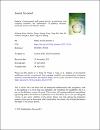Impacts of environment and human activity on grid-scale land cropping suitability and optimization of planting structure, measured based on the MaxEnt model
| المؤلف | Yang, Shiliang |
| المؤلف | Wang, Huimin |
| المؤلف | Tong, Jinping |
| المؤلف | Bai, Yang |
| المؤلف | Alatalo, Juha M. |
| المؤلف | Liu, Gang |
| المؤلف | Fang, Zhou |
| المؤلف | Zhang, Fan |
| تاريخ الإتاحة | 2022-04-24T07:49:38Z |
| تاريخ النشر | 2022-04-20 |
| اسم المنشور | Science of The Total Environment |
| المعرّف | http://dx.doi.org/10.1016/j.scitotenv.2022.155356 |
| الاقتباس | Yang, S., Wang, H., Tong, J., Bai, Y., Alatalo, J. M., Liu, G., ... & Zhang, F. (2022). Impacts of environment and human activity on grid-scale land cropping suitability and optimization of planting structure, measured based on the MaxEnt model. Science of the Total Environment, 836, 155356. |
| الرقم المعياري الدولي للكتاب | 0048-9697 |
| الملخص | Making full use of agricultural resource endowment, determining the planting suitability of areas for different crops according to the environment and human activities, and optimizing planting structure are important ways to ensure stable increases in crop yield and improve food production capacity. Taking Songhua River Basin (SRB) as an example, this study used geographic distribution information on different crops and the Maximum Entropy (MaxEnt) model to determine the degree of suitability of land in SRB for cropping, and to optimize the layout of crop planting structure. The results showed that the main factors affecting land suitability for different crops, with a combined contribution >80%, were population density, Distance from road to cultivated land, normalized difference vegetation index, and total phosphorus. Under the joint influence of the environment and human activity, the total unsuitable area of the four crops became much more extensive, with the unsuitable area of soybean being the largest (173 thousand km2) and the smallest for wheat (128 thousand km2). The highly suitable area was largest for wheat (2 thousand km2), while the other three crops were less than 2 thousand km2. Suitable distribution areas for all four crops were mainly located in the center of the basin (Songnen Plain) and in a wedge in the northeast corner (Sanjiang Plain). The relationships between different crops and environment and human activities revealed that crop suitability distribution is mainly determined by human activities, rather than the environment. These results provide a scientific basis for optimizing crop layout and improving the planting system, ensuring the security of food production. |
| راعي المشروع | This research was supported by the International Cooperation and Exchange of the National Natural Science Foundation of China (Grant No. 51861125101), National Social Science Fund (Grant No. 20BGL191), Sponsored by Blue Project of Colleges and Universities in Jiangsu Province (Teachers of Jiangsu [2018] No.12), Sponsored by Zijin Cultural Talent Project in Jiangsu Province (PDJPC [2020] No.96), Key Research Program of Frontier Sciences, CAS (Grant No. ZDBS-LY-7011), Key Program of National Social Science Foundation of China (Grant No. 17AZZ008). JMA was supported by Qatar Petroleum. |
| اللغة | en |
| الناشر | Elsevier |
| الموضوع | Climate change Human activity Food production Crops suitability Planting structure |
| النوع | Article |
| رقم المجلد | 836 |
| ESSN | 1879-1026 |
تحقق من خيارات الوصول
الملفات في هذه التسجيلة
هذه التسجيلة تظهر في المجموعات التالية
-
مجموعة علوم الأرض [217 items ]



